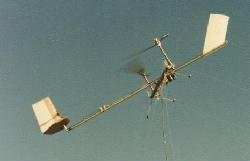Device Uses Helicopter Technology To Utilize High
Altitude Winds
What do a World War II code-cracker and an Australian
engineering professor have in common? A mutual desire to decrease
dependence on fossil fuels and a love of turbines, for
starters.

The two are developing a machine that is, essentially, a
helicopter that functions as a wind turbine -- an FEG (Flying
Electric Generator).
Conceived by Australian engineering specialist Professor Bryan
Roberts in 1979, the device is being developed by San Diego-based
SkyWindPower, headed up by David Shepard, who started his career
cracking Japanese military codes during WWII, according to CNN.
Shepard had been studying the power-producing potential of high
altitude winds for some 20 years when he heard about Roberts'
"gyromill" prototype. They combined their efforts in 2002 and the
FEG was born.
The theory is a turbine at a high altitude has the ability to
generate more power than one on the ground. They work on the
principle that wind speed and constancy are much better around the
Sub-Tropical Jet stream and the Polar Front Jet stream than at
ground level.
It is estimated the electricity needs of Earth could be met if
we could harness just one percent of that energy.
"The winds a few miles above the mid latitudes of the Northern
and Southern Hemispheres are far stronger and more persistent than
the winds just above us," Shepard said.
"This results in potentially being able to generate electricity
for over eighty percent of the time, as opposed to thirty percent
of the time at ground-based wind turbine sites.
"The largest ground-based wind turbines currently produce about
five megawatts each. We expect typical FEGs to produce about 20
megawatts each.
"We expect to make a demonstration in the US less than three
years from now at high altitude in normal high altitude winds. In
four years I would expect this sort of technology to be in active
use."
Shepard said he imagines "sky-farms" of FEGs much like current
wind farms on the ground. They would operate in restricted
airspace, of course.
Just 43 of these "farms" with 600 FEGs each would generate
sufficient electricity to sustain the entire US. "Our calculations
show that by reserving less than one four-hundredth of U.S. air
space, located at relatively remote locations not on airway routes,
all of America's electrical energy needs could be met," Shepard
said.
 "That is considerably
less airspace than is already restricted for other purposes,
primarily military."
"That is considerably
less airspace than is already restricted for other purposes,
primarily military."
The device itself works on helicopter technology. Each one is
formed like a giant 'H' and has four 37-foot blades at the four
points of the 'H' that function as rotors to provide lift. The
blades have dual functions. Not only do they provide lift, they
also function as turbines that turn the dynamos that generate the
electricity.
The electricity is then transported to the ground through a
tethering cable made of aluminum.
The unit will keep its horizontal and vertical position constant
by way of Global Positioning System technology.
Each unit would cost around $2,260,000 to build, but that also
includes maintenance and support, according to CNN. They would
generate electricity at about two cents per kilowatt hour while
conventional methods cost three to five cents per kilowatt
hour.
Like anything airborne, there are inherent risks involved.
Collisions could occur should aircraft enter FEG airspace
unknowingly or illegally; perhaps even more worrisome, one could
malfunction and drop.
"Inevitably crashes will occur," admits SkyWindPower on its web
site. "Just as airplane crashes occur. Statistically, however, FEGs
should be just as reliable as commercial airliners, whose safety
records are incredibly good.
"And FEGs don't take off or land at airports teeming with people
in and around them," the company adds.
 Airborne-Flight Training 05.09.24: ERAU at AIAA, LIFT Diamond Buy, Epic A&P
Airborne-Flight Training 05.09.24: ERAU at AIAA, LIFT Diamond Buy, Epic A&P ANN's Daily Aero-Term (05.07.24): Hazardous Weather Information
ANN's Daily Aero-Term (05.07.24): Hazardous Weather Information Aero-News: Quote of the Day (05.07.24)
Aero-News: Quote of the Day (05.07.24) NTSB Final Report: Cessna 150
NTSB Final Report: Cessna 150 Aero-News: Quote of the Day (05.08.24)
Aero-News: Quote of the Day (05.08.24)




